|
Step 8
|
Perform the following steps to verify the configuration that you have configured:
-
Verify the eBGP and iBGP VRF neighbors.
Router# show bgp vrf RFC5549 neighbors
BGP neighbor is 2001:DB8:2::1, vrf RFC5549
Remote AS 1, local AS 2, external link
Remote router ID 192.0.2.1
BGP state = Established, up for 00:03:37
Previous State: Idle
Last Received Message: KeepAlive
NSR State: None
Last read 00:00:32, Last read before reset 00:05:07
Hold time is 180, keepalive interval is 60 seconds
Configured hold time: 180, keepalive: 60, min acceptable hold time: 3
Last write 00:00:32, attempted 19, written 19
Second last write 00:01:32, attempted 19, written 19
Last write before reset 00:05:06, attempted 19, written 19
Second last write before reset 00:06:06, attempted 19, written 19
Last write pulse rcvd Mar 27 23:40:00.449 last full not set pulse count 79
Last write pulse rcvd before reset 00:05:06
Last insert into reset queue: Mar 27 23:36:20.435, removed at Mar 27 23:36:20.435
Socket not armed for io, armed for read, armed for write
Last write thread event before reset 00:04:12, second last 00:05:06
Last KA expiry before reset 00:05:06, second last 00:06:06
Last KA error before reset 00:00:00, KA not sent 00:00:00
Last KA start before reset 00:05:06, second last 00:06:06
Precedence: internet
Non-stop routing is enabled
Enforcing first AS is enabled
Multi-protocol capability received
Neighbor capabilities:
Route refresh: advertised (old + new) and received (old + new)
4-byte AS: advertised and received
Address family IPv4 Unicast: advertised and received
Received 42 messages, 0 notifications, 0 in queue
Sent 42 messages, 1 notifications, 0 in queue
Minimum time between advertisement runs is 0 secs
Inbound message logging enabled, 3 messages buffered
Outbound message logging enabled, 3 messages buffered
Fast fallover is enabled
Neighbor is directly connected
Neighbor fast-fallover is not configured
Neighbor is external and fast-external-fallover is not disabled
For Address Family: IPv4 Unicast
BGP neighbor version 10
Update group: 0.3 Filter-group: 0.4 No Refresh request being processed
AF-dependent capabilities:
Extended Nexthop Encoding: advertised and received
Route refresh request: received 0, sent 0
Policy for incoming advertisements is pass-all
Policy for outgoing advertisements is pass-all
1 accepted prefixes, 1 are bestpaths
Exact no. of prefixes denied: 0
Cumulative no. of prefixes denied: 0
Prefix advertised 1, suppressed 0, withdrawn 0
An EoR was received during read-only mode
Last ack version 10, Last synced ack version 0
Outstanding version objects: current 0, max 1, refresh 0
Additional-paths operation: None
Advertise routes with local-label via Unicast SAFI
Slow Peer State: Detection-only
Detected state: FALSE, Detection threshold: 300
Detection Count: 0, Recovery Count: 0
Connections established 2; dropped 1
Local host: 2001:DB8:2::2, Local port: 18907, IF Handle: 0x008001e0
Foreign host: 2001:DB8:2::1, Foreign port: 179
Last reset 00:04:12, due to Address family removed (CEASE notification sent - configuration change)
Time since last notification sent to neighbor: 00:04:12
Error Code: configuration change
Notification data sent:
None
BGP neighbor is 2001:DB9:2::3, vrf RFC5549
Remote AS 2, local AS 2, internal link
Remote router ID 192.0.2.3
BGP state = Established, up for 00:03:50
Previous State: Idle
Last Received Message: KeepAlive
NSR State: None
Last read 00:00:45, Last read before reset 00:05:06
Hold time is 180, keepalive interval is 60 seconds
Configured hold time: 180, keepalive: 60, min acceptable hold time: 3
Last write 00:00:32, attempted 19, written 19
Second last write 00:01:32, attempted 19, written 19
Last write before reset 00:05:06, attempted 19, written 19
Second last write before reset 00:06:06, attempted 19, written 19
Last write pulse rcvd Mar 27 23:40:00.459 last full not set pulse count 80
Last write pulse rcvd before reset 00:05:06
Last insert into reset queue: Mar 27 23:36:20.434, removed at Mar 27 23:36:20.434
Socket not armed for io, armed for read, armed for write
Last write thread event before reset 00:05:06, second last 00:05:06
Last KA expiry before reset 00:05:06, second last 00:06:06
Last KA error before reset 00:00:00, KA not sent 00:00:00
Last KA start before reset 00:05:06, second last 00:06:06
Precedence: internet
Non-stop routing is enabled
Multi-protocol capability received
Neighbor capabilities:
Route refresh: advertised (old + new) and received (old + new)
4-byte AS: advertised and received
Address family IPv4 Unicast: advertised and received
Received 42 messages, 0 notifications, 0 in queue
Sent 44 messages, 1 notifications, 0 in queue
Minimum time between advertisement runs is 0 secs
Inbound message logging enabled, 3 messages buffered
Outbound message logging enabled, 3 messages buffered
Fast fallover is not enabled
Neighbor is directly connected
Neighbor fast-fallover is not configured
For Address Family: IPv4 Unicast
BGP neighbor version 10
Update group: 0.1 Filter-group: 0.3 No Refresh request being processed
NEXT_HOP is always this router
AF-dependent capabilities:
Extended Nexthop Encoding: advertised and received
Route refresh request: received 0, sent 0
Policy for incoming advertisements is pass-all
Policy for outgoing advertisements is pass-all
1 accepted prefixes, 1 are bestpaths
Exact no. of prefixes denied: 0
Cumulative no. of prefixes denied: 0
Prefix advertised 1, suppressed 0, withdrawn 0
An EoR was received during read-only mode
Last ack version 10, Last synced ack version 0
Outstanding version objects: current 0, max 1, refresh 0
Additional-paths operation: None
Send Multicast Attributes
Advertise routes with local-label via Unicast SAFI
Slow Peer State: Detection-only
Detected state: FALSE, Detection threshold: 300
Detection Count: 0, Recovery Count: 0
Connections established 2; dropped 1
Local host: 2001:DB9:2::2, Local port: 179, IF Handle: 0x00800240
Foreign host: 2001:DB9:2::3, Foreign port: 19682
Last reset 00:04:12, due to Address family removed (CEASE notification sent - configuration change)
Time since last notification sent to neighbor: 00:04:12
Error Code: configuration change
Notification data sent:
None
-
Verify update groups for the eBGP and iBGP neighbours.
Router# show bgp vrf RFC5549 ipv4 unicast update-group
Update group for IPv4 Unicast, index 0.1:
Attributes:
Neighbor sessions are IPv6
Outbound policy: pass-all
Internal
Common admin
First neighbor AS: 2
Send communities
Send GSHUT community if originated
Send extended communities
Next-hop-self enabled
4-byte AS capable
Advertise routes with local-label via Unicast SAFI
Send multicast attributes
Extended Nexthop Encoding
Minimum advertisement interval: 0 secs
Update group desynchronized: 0
Sub-groups merged: 0
Number of refresh subgroups: 0
Messages formatted: 2, replicated: 2
All neighbor are assigned to sub-group(s)
Neighbors in sub-group: 0.1, Filter-Groups num:1
Neighbors in filter-group: 0.3(RT num: 0)
2001:DB9:2::3
Update group for IPv4 Unicast, index 0.3:
Attributes:
Outbound policy: pass-all
First neighbor AS: 1
Directly connected IPv6 EBGP
4-byte AS capable
Advertise routes with local-label via Unicast SAFI
Extended Nexthop Encoding
Minimum advertisement interval: 0 secs
Update group desynchronized: 0
Sub-groups merged: 0
Number of refresh subgroups: 0
Messages formatted: 2, replicated: 2
All neighbor are assigned to sub-group(s)
Neighbors in sub-group: 0.2, Filter-Groups num:1
Neighbors in filter-group: 0.4(RT num: 0)
2001:DB8:2::1
-
Verify eBGP and iBGP IPv4 routes with IPv6 nexthops.
Router# show bgp vrf RFC5549 ipv4 unicast
Wed Mar 27 23:41:44.494 IST
BGP VRF RFC5549, state: Active
BGP Route Distinguisher: 1:100
VRF ID: 0x60000003
BGP router identifier 100.1.1.2, local AS number 2
Non-stop routing is enabled
BGP table state: Active
Table ID: 0xe0000012 RD version: 10
BGP table nexthop route policy:
BGP main routing table version 10
BGP NSR Initial initsync version 6 (Reached)
BGP NSR/ISSU Sync-Group versions 0/0
Status codes: s suppressed, d damped, h history, * valid, > best
i - internal, r RIB-failure, S stale, N Nexthop-discard
Origin codes: i - IGP, e - EGP, ? - incomplete
Network Next Hop Metric LocPrf Weight Path
Route Distinguisher: 1:100 (default for vrf RFC5549)
Route Distinguisher Version: 10
*> 192.1.0.1/32 2001:DB8:2::1 0 0 1 ? N
*>i192.1.0.3/32 2001:DB9:2::3 0 100 0 ? N
Processed 2 prefixes, 2 paths
-
Verify eBGP route.
Router# show bgp vrf RFC5549 ipv4 unicast 192.1.0.1/32
BGP routing table entry for 192.1.0.1/32, Route Distinguisher: 1:100
Versions:
Process bRIB/RIB SendTblVer
Speaker 10 10
Local Label: 24004
Last Modified: Mar 27 23:37:00.000 for 00:04:54
Last Delayed at: ---
Paths: (1 available, best #1)
Advertised to CE peers (in unique update groups):
2001:DB9:2::3
Path #1: Received by speaker 0
Advertised to CE peers (in unique update groups):
2001:DB9:2::3
2001:DB8:2::1 from 2001:DB8:2::1 (192.0.2.1)
Origin incomplete, metric 0, localpref 100, valid, external, best, group-best, import-candidate
Received Path ID 0, Local Path ID 1, version 10
Origin-AS validity: (disabled)
-
Verify iBGP route.
Router# show bgp vrf RFC5549 ipv4 unicast 192.1.0.3/32
BGP routing table entry for 192.1.0.3/32, Route Distinguisher: 1:100
Versions:
Process bRIB/RIB SendTblVer
Speaker 9 9
Local Label: 24007
Last Modified: Mar 27 23:36:47.000 for 00:05:29
Last Delayed at: ---
Paths: (1 available, best #1)
Advertised to CE peers (in unique update groups):
2001:DB8:2::1
Path #1: Received by speaker 0
Advertised to CE peers (in unique update groups):
2001:DB8:2::1
Local
2001:DB9:2::3 from 2001:DB9:2::3 (192.0.2.3)
Origin incomplete, metric 0, localpref 100, valid, internal, best, group-best, import-candidate
Received Path ID 0, Local Path ID 1, version 9
-
Verify IPv6 nexthops for the eBGP and iBGP routes.
Router# show bgp vrf RFC5549 ipv4 unicast nexthops
Total Nexthop Processing
Time Spent: 0.000 secs
Maximum Nexthop Processing
Received: 00:00:00
Bestpaths Deleted: 0
Bestpaths Changed: 0
Time Spent: 0.000 secs
Last Notification Processing
Received: 00:37:03
Time Spent: 0.000 secs
IPv4 Unicast is active
Gateway Address Family: IPv4 Unicast
Table ID: 0xe0000012
Gateway Reference Count: 1
Gateway AF Bits : 0x1
Nexthop Count: 0
Critical Trigger Delay: 50msec
Non-critical Trigger Delay: 10000msec
Nexthop Version: 1, RIB version: 1
EPE Table Version: 1, EPE Label version: 0
EPE Downloaded Version: 0, EPE Standby Version: 0
IPv4 Unicast is active
Gateway Address Family: IPv6 Unicast
Table ID: 0xe0800012
Gateway Reference Count: 4
Gateway AF Bits : 0x1
Nexthop Count: 2
Critical Trigger Delay: 50msec
Non-critical Trigger Delay: 10000msec
Nexthop Version: 3, RIB version: 1
EPE Table Version: 1, EPE Label version: 0
EPE Downloaded Version: 0, EPE Standby Version: 0
Status codes: R/UR Reachable/Unreachable
C/NC Connected/Not-connected
L/NL Local/Non-local
PR Pending Registration
I Invalid (Policy drop)
Next Hop Status Metric Tbl-ID Notf LastRIBEvent RefCount
2001:DB8:2::1 [R][C][NL] 0 e0800012 1/0 00:37:03 (Cri) 1/3
2001:DB9:2::3 [R][C][NL] 0 e0800012 1/0 00:37:03 (Cri) 1/4
Counters
Next Hop Reachable Unreachable MetricIncrease MetricDecrease
2001:DB8:2::1 1 0 0 0
2001:DB9:2::3 1 0 0 0
-
Verify IPv6 nexthop for the eBGP route.
Router# show bgp vrf RFC5549 ipv4 unicast nexthops 2001:DB8:2::1
Nexthop: 2001:DB8:2::1
VRF: RFC5549
Nexthop ID: 0x6000001, Version: 2
Nexthop Flags: 0x00020082
Nexthop Handle: 0x211b390
Tree Nexthop Handle: 0x211b390
Advertising neighbors:
2001:DB8:2::1
RIB Related Information:
Firsthop interface handle 0x008001e0
Gateway TBL Id: 0xe0800012 Gateway Flags: 0x00000080
Gateway Handle: 0x24c35a8
Gateway: reachable, Connected route, prefix length 64
Resolving Route: 2001:DB8:2::/64 (connected)
Paths: 1
RIB Nexhop ID: 0x20010
Nexthop sync slot: 23
Status: [Reachable][Connected][Not Local]
Metric: 0
ORR afi bits: 0x0
Registration: Asynchronous, Completed: 00:37:16
Events: Critical (1)/Non-critical (0)
Last Received: 00:37:16 (Critical)
Last gw update: (Crit-notif) 00:37:16(rib)
Reference Count: 1
Reachable Notifications: 1 (last at Mar 27 23:06:16.748)
Unreachable Notifications: 0
Metric Increase Notifications: 0
Metric Decrease Notifications: 0
Most Recent Events:
Time Event Type Metric
Mar 27 23:06:16.748 Reachable 0
Prefix Related Information
Active Tables: [IPv4 Unicast]
Metrices: [0xffffffff]
Reference Counts: [1]
Encapsulations: []
Interface Handle: 0x0
Linked Nexthop Count: 1
Attr ref-count: 3
-
Verify IPv6 nexthop for the eBGP route.
Router# show bgp vrf RFC5549 ipv4 unicast nexthops 2001:DB9:2::3
Nexthop: 2001:DB9:2::3
VRF: RFC5549
Nexthop ID: 0x6000002, Version: 3
Nexthop Flags: 0x00000082
Nexthop Handle: 0x211b130
Tree Nexthop Handle: 0x211b130
RIB Related Information:
Firsthop interface handle 0x00800240
Gateway TBL Id: 0xe0800012 Gateway Flags: 0x00000080
Gateway Handle: 0x24c34f0
Gateway: reachable, Connected route, prefix length 64
Resolving Route: 2001:DB9:2::/64 (connected)
Paths: 0
RIB Nexhop ID: 0x20011
Nexthop sync slot: 30
Status: [Reachable][Connected][Not Local]
Metric: 0
ORR afi bits: 0x0
Registration: Asynchronous, Completed: 00:37:24
Events: Critical (1)/Non-critical (0)
Last Received: 00:37:24 (Critical)
Last gw update: (Crit-notif) 00:37:24(rib)
Reference Count: 1
Reachable Notifications: 1 (last at Mar 27 23:06:16.748)
Unreachable Notifications: 0
Metric Increase Notifications: 0
Metric Decrease Notifications: 0
Most Recent Events:
Time Event Type Metric
Mar 27 23:06:16.748 Reachable 0
Prefix Related Information
Active Tables: [IPv4 Unicast]
Metrices: [0xffffffff]
Reference Counts: [1]
Encapsulations: []
Interface Handle: 0x0
Attr ref-count: 4
-
Verify eBGP and iBGP routes in RIB.
Router# show route vrf RFC5549 192.1.0.1/32
Wed Mar 27 23:46:00.095 IST
Routing entry for 192.1.0.1/32
Known via "bgp 2", distance 20, metric 0
Tag 1
Local Label 24004, type external
Installed Mar 27 23:37:00.244 for 00:09:00
Routing Descriptor Blocks
fe80::83:9eff:fe38:c59f, from 2001:DB8:2::1, via GigabitEthernet0/1/0/0.2, BGP external
Nexthop in Vrf: "RFC5549", Table: "default", IPv6 Unicast, Table Id: 0xe0800012
Route metric is 0
No advertising protos.
Router# show route vrf RFC5549 192.1.0.3/32
Routing entry for 192.1.0.3/32
Known via "bgp 2", distance 200, metric 0
Local Label 24007, type internal
Installed Mar 27 23:36:47.287 for 00:09:28
Routing Descriptor Blocks
2001:DB9:2::3, from 2001:DB9:2::3
Nexthop in Vrf: "RFC5549", Table: "default", IPv6 Unicast, Table Id: 0xe0800012
Route metric is 0
No advertising protos.
-
Verify eBGP and iBGP routes in RIB with the detail option.
Router# show route vrf RFC5549 192.1.0.3/32 detail
Routing entry for 192.1.0.3/32
Known via "bgp 2", distance 20, metric 0
Tag 1, type external
Installed Mar 27 23:37:00.244 for 00:09:32
Routing Descriptor Blocks
fe80::83:9eff:fe38:c59f, from 2001:DB8:2::1, via GigabitEthernet0/1/0/0.2, BGP external
Nexthop in Vrf: "RFC5549", Table: "default", IPv6 Unicast, Table Id: 0xe0800012
Route metric is 0
Label: None
Tunnel ID: None
Binding Label: None
Extended communities count: 0
NHID: 0x0 (Ref: 0)
Path Grouping ID: 1
Route version is 0x2 (2)
Local Label: 0x5dc4 (24004)
IP Precedence: Not Set
QoS Group ID: Not Set
Flow-tag: Not Set
Fwd-class: Not Set
Route Priority: RIB_PRIORITY_RECURSIVE (10) SVD Type RIB_SVD_TYPE_LOCAL
Download Priority 3, Download Version 59
No advertising protos.
Router# show route vrf RFC5549 192.1.0.3/32 detail
Routing entry for 192.1.0.3/32
Known via "bgp 2", distance 200, metric 0, type internal
Installed Mar 27 23:36:47.287 for 00:09:52
Routing Descriptor Blocks
23:2:2::3, from 23:2:2::3
Nexthop in Vrf: "RFC5549", Table: "default", IPv6 Unicast, Table Id: 0xe0800012
Route metric is 0
Label: None
Tunnel ID: None
Binding Label: None
Extended communities count: 0
NHID: 0x0 (Ref: 0)
Path Grouping ID: 2
Route version is 0x2 (2)
Local Label: 0x5dc7 (24007)
IP Precedence: Not Set
QoS Group ID: Not Set
Flow-tag: Not Set
Fwd-class: Not Set
Route Priority: RIB_PRIORITY_RECURSIVE (10) SVD Type RIB_SVD_TYPE_LOCAL
Download Priority 3, Download Version 57
No advertising protos.
-
Verify eBGP and iBGP routes in CEF.
Router# show cef vrf RFC5549 192.1.0.1/32
192.1.0.1/32, version 59, internal 0x1000001 0x30 (ptr 0x61c125a8) [1], 0x600 (0x6379bc58), 0xa20 (0x632aa3b8)
Updated Mar 27 23:37:00.247
remote adjacency to GigabitEthernet0/1/0/0.2
Prefix Len 32, traffic index 0, precedence n/a, priority 3
gateway array (0x6441c190) reference count 2, flags 0x8068, source rib (7), 0 backups
[3 type 4 flags 0x108401 (0x632c83b0) ext 0x0 (0x0)]
LW-LDI[type=1, refc=1, ptr=0x6379bc58, sh-ldi=0x632c83b0]
gateway array update type-time 1 Mar 27 23:37:00.247
LDI Update time Mar 27 23:37:00.247
LW-LDI-TS Mar 27 23:37:00.247
via fe80::83:9eff:fe38:c59f/128, GigabitEthernet0/1/0/0.2, 4 dependencies, weight 0, class 0, bgp-ext [flags 0x6020]
path-idx 0 NHID 0x0 [0x632e75a0 0x0]
next hop VRF - 'RFC5549', table - 0xe0800012
next hop fe80::83:9eff:fe38:c59f/128
remote adjacency
local label 24004 labels imposed {None}
Load distribution: 0 (refcount 3)
Hash OK Interface Address
0 Y GigabitEthernet0/1/0/0.2 remote
Router# show cef vrf RFC5549 192.1.0.3/32
192.1.0.3/32, version 57, internal 0x1000001 0x30 (ptr 0x61c12698) [1], 0x0 (0x0), 0x200 (0x632aa1d8)
Updated Mar 27 23:36:47.289
remote adjacency to GigabitEthernet0/1/0/1.2
Prefix Len 32, traffic index 0, precedence n/a, priority 3
gateway array (0x6441c098) reference count 2, flags 0xa078, source rib (7), 0 backups
[1 type 4 flags 0x148501 (0x632c8358) ext 0x0 (0x0)]
LW-LDI[type=0, refc=0, ptr=0x0, sh-ldi=0x0]
gateway array update type-time 1 Mar 27 23:36:47.289
LDI Update time Mar 27 23:36:47.367
via 2001:DB9:2::3/128, 2 dependencies, recursive [flags 0x6000]
path-idx 0 NHID 0x0 [0x61c7a398 0x0]
next hop VRF - 'RFC5549', table - 0xe0800012
next hop 2001:DB9:2::3/128 via 2001:DB9:2::3/128
local label 24007
next hop 2001:DB9:2::3/128 Gi0/1/0/1.2 labels imposed {None}
Load distribution: 0 (refcount 1)
Hash OK Interface Address
0 Y GigabitEthernet0/1/0/1.2 remote
-
Verify eBGP and iBGP routes in CEF with the detail option.
Router# show cef vrf RFC5549 192.1.0.1/32 detail
192.1.0.1/32, version 59, internal 0x1000001 0x30 (ptr 0x61c125a8) [1], 0x600 (0x6379bc58), 0xa20 (0x632aa3b8)
Updated Mar 27 23:37:00.247
remote adjacency to GigabitEthernet0/1/0/0.2
Prefix Len 32, traffic index 0, precedence n/a, priority 3
gateway array (0x6441c190) reference count 2, flags 0x8068, source rib (7), 0 backups
[3 type 4 flags 0x108401 (0x632c83b0) ext 0x0 (0x0)]
LW-LDI[type=1, refc=1, ptr=0x6379bc58, sh-ldi=0x632c83b0]
gateway array update type-time 1 Mar 27 23:37:00.247
LDI Update time Mar 27 23:37:00.247
LW-LDI-TS Mar 27 23:37:00.247
via fe80::83:9eff:fe38:c59f/128, GigabitEthernet0/1/0/0.2, 4 dependencies, weight 0, class 0, bgp-ext [flags 0x6020]
path-idx 0 NHID 0x0 [0x632e75a0 0x0]
next hop VRF - 'RFC5549', table - 0xe0800012
next hop fe80::83:9eff:fe38:c59f/128
remote adjacency
local label 24004 labels imposed {None}
Load distribution: 0 (refcount 3)
Hash OK Interface Address
0 Y GigabitEthernet0/1/0/0.2 remote
Router# show cef vrf RFC5549 192.1.0.3/32 detail
192.1.0.3/32, version 57, internal 0x1000001 0x30 (ptr 0x61c12698) [1], 0x0 (0x0), 0x200 (0x632aa1d8)
Updated Mar 27 23:36:47.289
remote adjacency to GigabitEthernet0/1/0/1.2
Prefix Len 32, traffic index 0, precedence n/a, priority 3
gateway array (0x6441c098) reference count 2, flags 0xa078, source rib (7), 0 backups
[1 type 4 flags 0x148501 (0x632c8358) ext 0x0 (0x0)]
LW-LDI[type=0, refc=0, ptr=0x0, sh-ldi=0x0]
gateway array update type-time 1 Mar 27 23:36:47.289
LDI Update time Mar 27 23:36:47.367
via 2001:DB9:2::3/128, 2 dependencies, recursive [flags 0x6000]
path-idx 0 NHID 0x0 [0x61c7a398 0x0]
next hop VRF - 'RFC5549', table - 0xe0800012
next hop 2001:DB9:2::3/128 via 2001:DB9:2::3/128
local label 24007
next hop 2001:DB9:2::3/128 Gi0/1/0/1.2 labels imposed {None}
Load distribution: 0 (refcount 1)
Hash OK Interface Address
0 Y GigabitEthernet0/1/0/1.2 remote
|





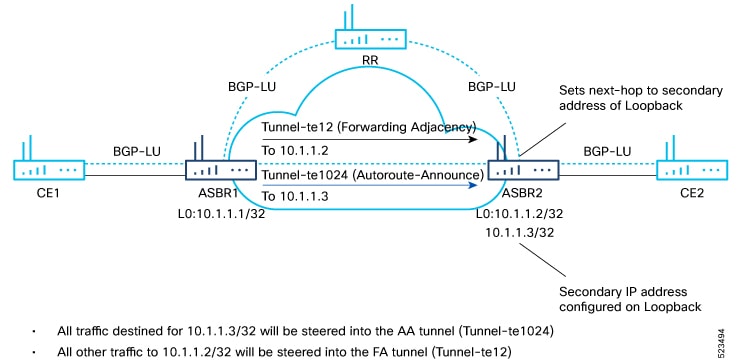
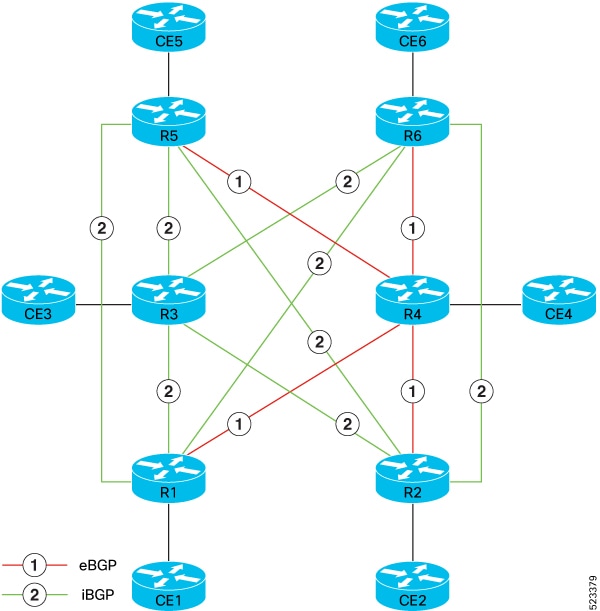
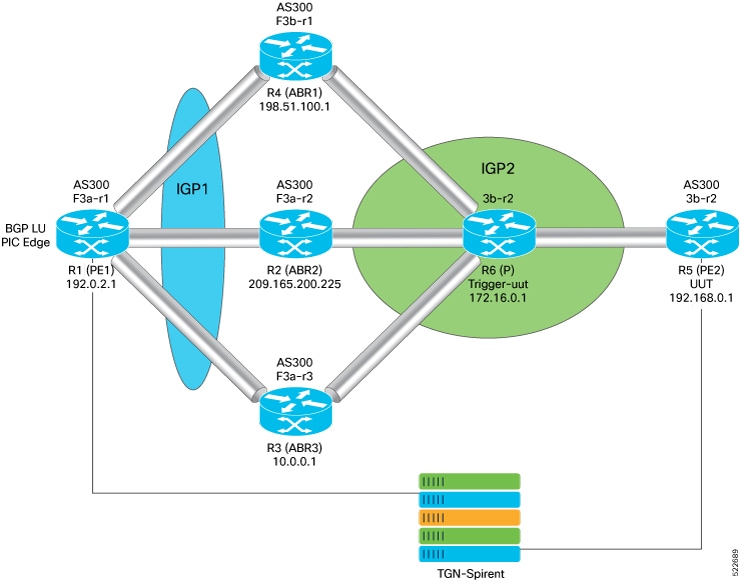






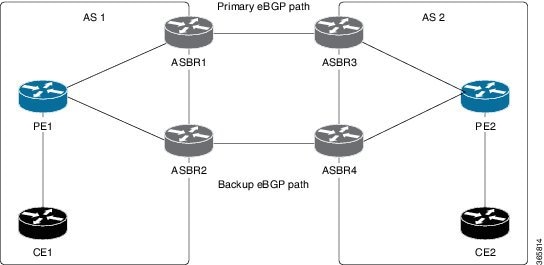



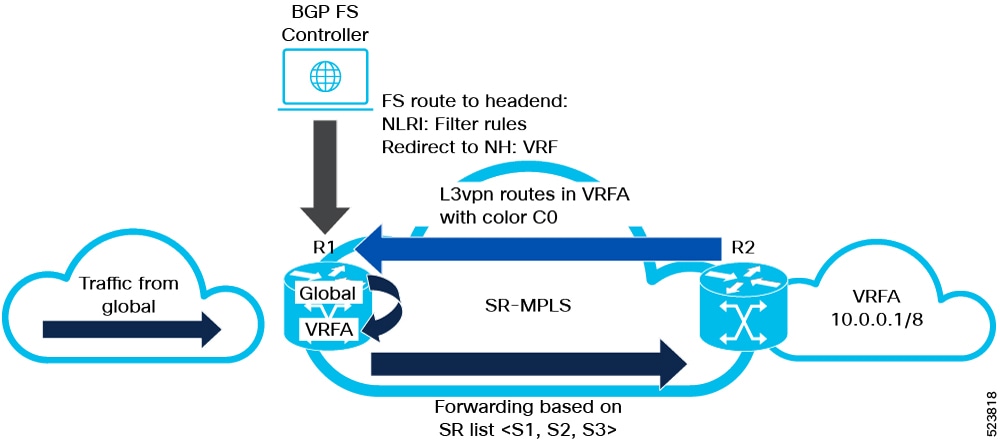












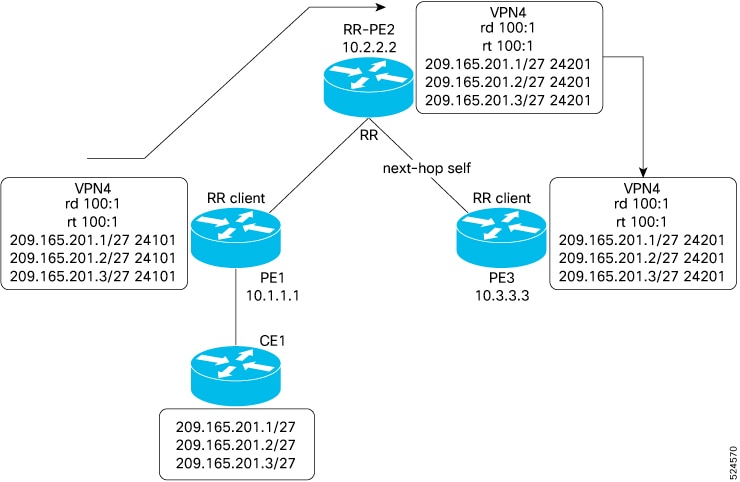
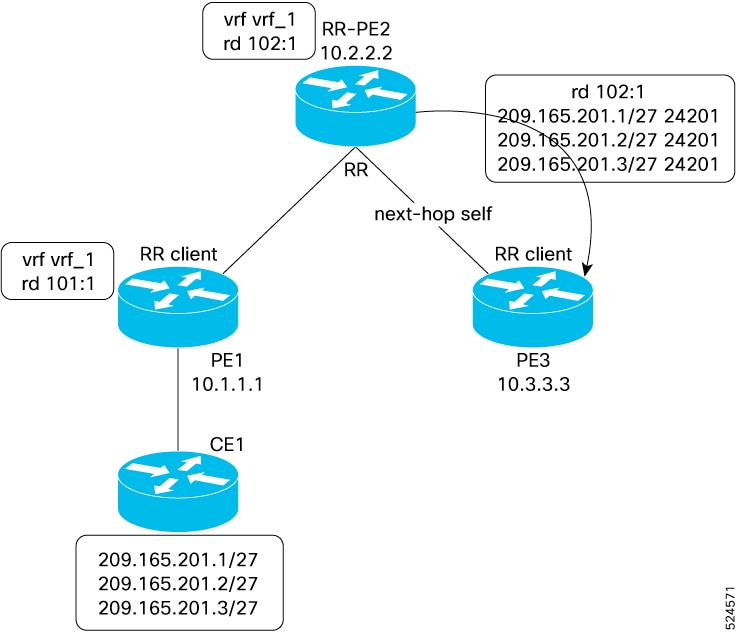
 Feedback
Feedback